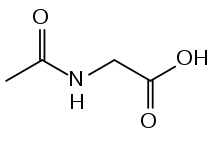Aceturic acid
 | |
| Names | |
|---|---|
| IUPAC name
2-acetamidoacetic acid | |
| Other names
N-acetylglycine acetamidoacetic acid acetylglycocoll | |
| Identifiers | |
3D model (JSmol) |
|
| Abbreviations | AcGly |
| ChemSpider | |
| ECHA InfoCard | 100.008.036 |
PubChem CID |
|
| |
| |
| Properties | |
| C4H7NO3 | |
| Molar mass | 117.10 g·mol−1 |
| Appearance | White powder or needles |
| Melting point | 206 to 208 °C (403 to 406 °F; 479 to 481 K) |
| 2.7% at 15 °C | |
| Acidity (pKa) | 3.64 |
| Hazards | |
| S-phrases (outdated) | S24/25 |
| Related compounds | |
Related compounds |
N-Acetylglycinamide |
Except where otherwise noted, data are given for materials in their standard state (at 25 °C [77 °F], 100 kPa). | |
| Infobox references | |
Aceturic acid (N-acetylglycine) is a derivative of the amino acid glycine. Its salts are called aceturates.
Preparation
Aceturic acid can be prepared by warming glycine either with a slight excess of acetic anhydride in benzene,[1] or with an equal molar amount of acetic anhydride in glacial (concentrated) acetic acid.[2]
See also
References
- ↑ Curtius, Th.; Radenhausen, R. (1895). "Hydrazide und Azide organischer Säuren. X Abhandlung. 35. Ueber Hydrazide substituirter Amidosäuren und das Hydrazid der Fumarsäure". J. Prakt. Chem. 52 (1): 433–454. doi:10.1002/prac.18950520134.
- ↑ Dakin, H. D. (1929). "The Condensation of Aromatic Aldehydes with Glycine and Acetylglycine" (PDF). J. Biol. Chem. 82 (2): 439–446.
This article is issued from
Wikipedia.
The text is licensed under Creative Commons - Attribution - Sharealike.
Additional terms may apply for the media files.